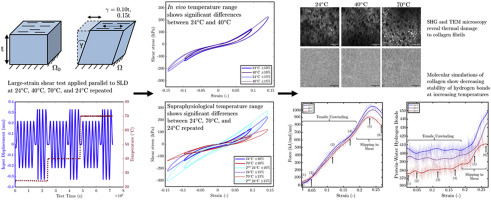Journal of the Mechanical Behavior of Biomedical Materials ( IF 3.3 ) Pub Date : 2019-12-17 , DOI: 10.1016/j.jmbbm.2019.103595 Lauren Marshall 1 , Anna Tarakanova 2 , Phoebe Szarek 3 , David M Pierce 2

|
Human joints, particularly those of extremities, experience a significant range of temperatures in vivo. Joint temperature influences the mechanics of both joint and cartilage, and the mechanics of cartilage can affect the temperature of both joint and cartilage. Thermal treatments and tissue repairs, such as thermal chondroplasty, and ex vivo tissue engineering may also expose cartilage to supraphysiological temperatures. Furthermore, although cartilage undergoes principally compressive loads in vivo, shear strain plays a significant role at larger compressive strains. Thus, we aimed to determine whether and how the bulk mechanical responses of cartilage undergoing large-strain shear change (1) within the range of temperatures relevant in vivo, and (2) both during and after supraphysiological thermal treatments. We completed large-strain shear tests (10 and 15%) at four thermal conditions: 24∘C and 40∘C to span the in vivo range, and 70∘C and 24∘C repeated after 70∘C to explore mechanics during and after potential treatments. We calculated the bulk mechanical responses (strain-energy dissipation densities, peak-to-peak shear stresses, and peak-effective shear moduli) as of function of temperature and used statistical methods to probe significant differences. To probe the mechanisms underlying differences we assessed specimens, principally the type II collagen, with imaging (second harmonic generation and transmission electron microscopies, and histology) and assessed the temperature-dependent mechanics of type II collagen molecules within cartilage using steered molecular dynamics simulations. Our results suggest that the bulk mechanical responses of cartilage depend significantly on temperature both within the in vivo range and at supraphysiological temperatures, showing significant reductions in all mechanical measures with increasing temperature. Using imaging and simulations we determined that one underlying mechanism explaining our results may be changes in the molecular deformation profiles of collagen molecules versus temperature, likely compounded at larger length scales. These new insights into the mechanics of cartilage and collagen may suggest new treatment targets for damaged or osteoarthritic cartilage.
中文翻译:

体内和超生理温度下大应变剪切下的软骨和胶原力学。
人体关节,特别是四肢关节,在体内会经历很大范围的温度变化。关节温度影响关节和软骨的力学,而软骨力学可以影响关节和软骨的温度。热处理和组织修复(例如热软骨成形术)和离体组织工程也可能使软骨暴露于超生理温度。此外,尽管软骨在体内主要承受压缩负荷,但是剪切应变在较大的压缩应变中起着重要的作用。因此,我们的目的是确定在体内相关温度范围内,软骨的大力学响应是否以及如何经历大应变剪切变化(1)。,以及(2)在超生理热处理期间和之后。我们完成了大应变剪切试验(10和15%)在四个热条件:24 ∘ ℃和40 ∘ C到跨越体内范围内,并且70 ∘ C和24 ∘ C 70之后,重复∘C探索潜在治疗期间和之后的力学。我们计算了随温度变化的整体机械响应(应变能耗散密度,峰峰剪切应力和峰有效剪切模量),并使用统计方法探究了显着差异。为了探究差异的潜在机制,我们评估了标本,主要是II型胶原蛋白,并进行了成像(二次谐波生成和透射电子显微镜检查以及组织学),并使用转向分子动力学模拟评估了软骨内II型胶原蛋白分子的温度依赖性力学。我们的结果表明,软骨的整体机械反应在很大程度上取决于体内的温度范围和超生理温度下,随着温度的升高,所有机械措施均显着降低。通过成像和模拟,我们确定了解释我们结果的一种潜在机制可能是胶原分子的分子变形曲线随温度的变化,可能会在更大的长度范围内复合。这些关于软骨和胶原蛋白力学的新见解可能会为受损或骨关节炎的软骨提出新的治疗目标。











































 京公网安备 11010802027423号
京公网安备 11010802027423号